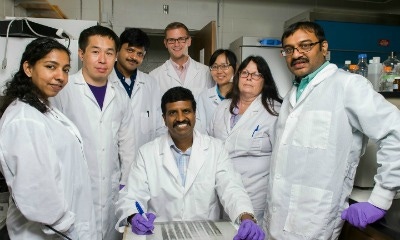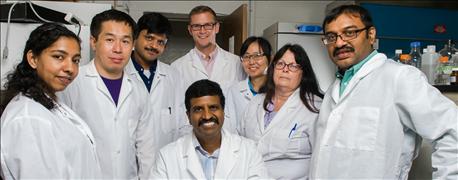
Most Kansas ranchers have never heard of Ehrlichia ruminantium, the novel pathogen that causes heartwater, a disease that is deadly too cattle, sheep and goats.
That's because, so far, it has only been found in sub-Saharan Africa where it was initially identified and in several Caribbean islands where it has spread.
However, heartwater and other foreign animal diseases like it are exactly the kinds of threats that the Biosecurity Research Institute scientists at Kansas State University are working to study and develop vaccines against -- those that have the potential for catastrophic consequences if introduced to the U.S. mainland.

THE TEAM: Director Roman Ganta, seated in center, with his Kansas State University Center of Excellence for Vector-Borne Diseases team, from left: Arathy Nair, Huitao Liu, Vijay K. Eedunuri, Tanner Slead, Chuanmin Cheng, Deborah Jaworski and Laxmi U.M.R. Jakkula.
Two tick species in the U.S. have been identified as vectors for the tick-borne pathogen. The cattle egret, a migratory bird, has also been identified through its migratory patterns, as a potential vehicle for infected ticks to enter the American mainland.
The possible introduction of the disease from the Caribbean and through imported exotic foreign animals from Africa is a major concern for heartwater establishment in the U.S. The U.S. Department of Agriculture estimates that if heartwater disease is introduced, it could cause up to $2.3 billion in losses to the U.S. economy.
K-State's Center of Excellence for Vector-Borne Diseases has obtained $200,000 from the state of Kansas through its National Bio and Agro-defense Facility Transition Fund work on Ehrlichia ruminantium.
The center's director, Roman Ganta, professor of diagnostic medicine and pathobiology in the College of Veterinary Medicine, said a corporate gift was used as a matching-fund component for obtaining the transitional-funding grant.
"We have been quite fortune to have strong annual support from Abaxis, a cutting-edge medical and veterinary technology company that provided us with a $250,000 gift earlier this year," Ganta said. "Our expertise in vector-borne disease research and the availability of a high containment facility at the BRI and the future establishment of the NBAF in Manhattan give us a unique ability to study a pathogen that has not been studied before in the U.S."
The disease's name, heartwater, is derived from the hydropericardium symptoms that are commonly seen with it. The disease is characterized by fever, neurological signs, hydrothorax, ascites, edema of the lungs and high mortality rates up to 90 percent can occur in livestock if introduced into a non-endemic area, such as to the mainland U.S.
Ganta said "The long-term goal of our proposed research is to develop live-attenuated vaccines and to improve any inactivated vaccines to protect ruminants against heartwater in the U.S. and abroad," Ganta said. "Currently, there are no approved drugs or vaccines against heartwater disease in the U.S."
The research is part of Kansas State University's leadership in addressing the growing technological, educational and human resource needs of the global food system. It also shows how Kansas State University is working to become a Top 50 public research university by 2025.
Ganta and Jodi McGill, an assistant professor of diagnostic medicine and pathobiology, will serve as the principal investigator and co-principal investigator, respectively, for the project. They will be assisted by Kathryn Reif, an assistant professor of diagnostic medicine and pathobiology.
The Center of Excellence for Vector Borne-Diseases is an interdisciplinary research center focused on pathogenesis, surveillance and prevention of tick-borne diseases and other vector-borne diseases of significant importance to animal and human health. The goals of the center are to prepare Kansas State University for building a strong program on vector-borne diseases, establishing a tick rearing facility, developing a network to build collaborative research involving scientists from the university with other academic institutions from the U.S. and abroad, training new generation of scientists with expertise on vector-borne diseases, developing and offering continuing education workshops, and developing additional resources.
Material from the Kansas State University News Service was used in this article.
About the Author(s)
You May Also Like






